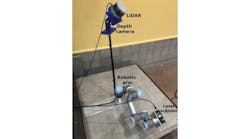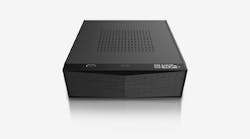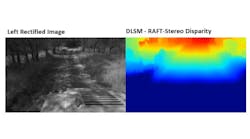DECEMBER 13--A remote, historic copper-mining center on UNESCO's list of priceless world historical sites has implemented remote monitoring technology, the Mikron Infrared DualVision system, for 24-hour surveillance and early detection of fire in 17th century wooden buildings. Merging visual imaging with thermal imaging and temperature measurement, the DualVision system is mounted on a pan-and-tilt head in the city's church tower and is remotely controlled from a PC at the local fire station.
The city center of Røros, Norway, is under a preservation order and is listed by UNESCO (United Nations Educational, Scientific and Cultural Organization) as one of the world's cultural treasures, in company with Versailles and the pyramids of Egypt. A mining settlement dating from 1644, the area has many surviving buildings that are characteristic of a traditional settlement built with methods of the period. The city has preserved its 17th century layout, and its center has a distinct medieval appearance with about 80 authentic wooden houses, many with their original pitch-log facades looking out on courtyards. Both the wood-built center and a larger area around the town, with traces of 300 years of mining history, are on the World Heritage List.
Densely packed, historic wooden town centers are common in Nordic cities, providing plenty of fuel and limited access for firefighting brigades to respond quickly and effectively. This is compounded in remote areas where there may be no electricity, water supply, or fire brigade. Fires spread rapidly, and historic town centers have been partially or completely destroyed in the past.
The Røros area is already equipped with sprinklers and sensors, but the Directorate for Cultural Heritage, working through the consulting firm of COWI ASA of Trondheim, enlisted SR Automation AS (Asker) to add DualVision imaging technology to provide another layer of protection, as well as 24-hour physical surveillance.
DualVision combines visual and infrared imaging/temperature measurement to produce a single composite, blended image for simple, quick analysis. The resulting composite can be viewed in an infinitely blended percentage of visual/IR, simply by moving a slider bar in the software screen. The system also provides separate infrared and visual feeds. In terms of fire detection, the field of view of the IR camera can be divided into 32 user-defined regions of interest (ROIs), each with its own temperature-alarm setpoints. ROIs in the image can be defined using 10 different shapes, including freehand. The system can be configured to trigger alarms at the fire station due to temperature excursions caused by fire or the body heat of intruders. Daylight surveillance with the visual camera can be enhanced at night with the gray-scale infrared image, making it possible to see troublemakers even in pitch-black darkness, following their heat signatures.
The DualVision system consists of separate thermal imaging and video cameras housed in a single NEMA-4-rated, temperature-controlled enclosure. "This enclosure is designed to ensure the survival and function of the cameras in the Røros climate, which easily hits -50°C during an extremely long winter," said Rannei Heldal, managing director of SR Automation. Both cameras have Internet IP addresses and password protection, allowing control from any computer using wired or wireless Ethernet.
The DualVision system is operated from a PC at the fire station, using Mikron's MikroSpec Real-Time Thermal Data Acquisition and Analysis software. The software blends the thermal and IR camera feeds into a single DualVision image with correct aspect ratio and spatial area. By applying an isotherm color pallet to the IR image, hot spots are easily identified while still viewing the scene as a visual image. The composite image can be adjusted to show any percentage of the IR and visual, allowing firefighters to quickly assess an alarm situation before sending equipment to a scene.
The MikroSpec R/T software can also record up to 75 minutes of 30-Hz blended visual and IR video to a hard drive, too. Total record time can be greatly extended by capturing images at intervals, rather than continuously. Video capture can be triggered by a temperature alarm from one of the ROI's or by direct signal from the PC. A user-selectable prebuffer of video allows the operator to also capture what happened in a scene before an event trigger.




